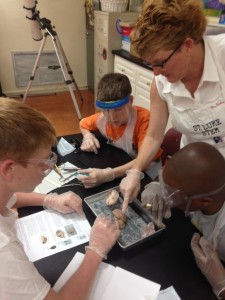
On a summer morning when some middle schoolers were sleeping in or headed to the beach, 12-year-old Ariana Rendona and two dozen other students were in a classroom at St. Luke Catholic School, using X-acto knives to slice up sheep brain. Behind goggles and lab coats, they took turns differentiating grey matter from white matter and cerebrum from cerebellum.
“Disgusting but fun,” Ariana said.
For she and other students at St. Luke, a PreK-8 school that serves a heavily Hispanic population in Palm Springs, Fla., science immersion has suddenly become a thing. Over the past 18 months, St. Luke has done what many schools, public and private, either can’t or won’t: make STEM a priority.
It added 20 minutes to the school day just for STEM, hired a STEM coordinator, invested in STEM-oriented professional development for the entire teaching staff and instituted a two-week STEM summer camp for students like Ariana. Much of this has been done in partnership with the new Center for STEM Education at Notre Dame, an outfit that has quickly and quietly launched several projects aimed at bolstering science instruction in Catholic schools and beyond.
The result: Engaged students. Happy parents. Another potential selling point for a private school in an increasingly competitive school choice market. And who knows? Maybe, just maybe, a template and inspiration for other schools.
About three-fourths of the 170 students at St. Luke are minorities, and nearly 70 of them use the state’s tax credit scholarship program for low-income students. (The program is administered by non-profits like Step Up For Students, which co-hosts this blog.) For them, more exposure to high-quality STEM instruction is especially important, said Sue Sandelier, St. Luke’s principal, and Diann Bacchus, its science coordinator.
“Money is a struggle for many of the families here” but solid grounding in STEM can lead to high-paying careers for their children, said Bacchus, a longtime educator in both public and private schools. “I see it as their way out.”
St. Luke’s aims are notable for all kinds of reasons.
Science educators bemoan the lack of attention to science instruction, and outcomes suggest it has led to lackluster results. Florida schools, for instance, have made some of the biggest K-12 academic gains in the nation over the past 15 years, but that traction hasn’t extended to science. Low-income students, especially, continue to fare poorly. The most recent state assessment (where demographic breakdowns are available) shows 37 percent of low-income Florida eighth-graders are proficient in science. The most recent national assessment shows 18 percent are.
Some state education leaders express frustration, but not enough of them to suggest any kind of state push, any time soon.
Meanwhile, a new report from Georgetown University underscores the missed opportunity. College-educated workers with STEM degrees are the top earners with both entry-level and mid-career jobs, with nine of the 10 highest-paying majors in engineering. (Pharmacy is the other.)
Sandelier said many schools, public and private, have failed to make STEM a bigger priority in part because of urgency in beefing up other critical areas, like reading. (There are some notable exceptions.) But perhaps the pendulum has swung, she said. She credited St. Luke’s faculty for buying in to the new direction, and for putting in the hard work needed to start blazing a path.
Among other efforts, the school is participating in Project Lead The Way, which seeks to transform STEM education with better curriculum and professional development. Bacchus was tapped as a teaching fellow by the Notre Dame STEM center, which puts a strong emphasis on professional development. St. Luke also sends frequent updates to the center, which constantly offers tips and feedback.
The bottom line is more and better science instruction. And, according to the students, more fun.
“I liked learning about ecosystems, about how biotic and abiotic factors worth together,” Ariana said, referring to recent classes. Science “can help people learn about how the world works.”
At camp, the texture of sheep brain reminded 12-year-old Tyler Dempsey of a pizza that had the cheese stripped off. The day before, he couldn’t help but mention, he and other students got to see black stuff ooze from a sheep’s eyeball.
“Really cool,” Tyler said. “I love to see how everything is made possible.”
Parents, too, appreciate the STEM focus, Sandelier said. They’re excited when their kids are excited, she said. And it’s not lost on them what kind of doors may open if that interest is sustained.
“I told the parents,” she said, “they better start saving up for MIT.”



[…] St. Luke Catholic School in Palm Springs is going all in on STEM, reports a Florida education blog. […]
[…] these results, and Ron Matus for having the idea for this analysis. Ron recently wrote a profile of a high-poverty Catholic school where science is a priority for […]